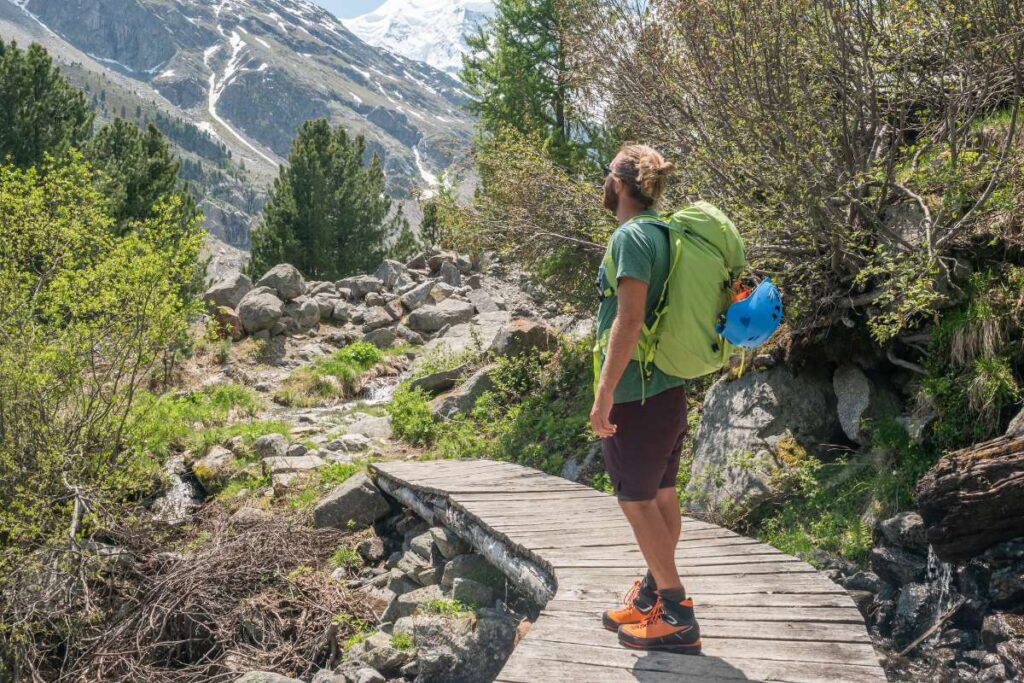Embarking on a hiking journey may seem intimidating for beginners, but with the right guidance and preparation, it can be an enjoyable and rewarding activity.
Hiking for beginners involves taking the time to understand the basics, including selecting an appropriate trail, as well as estimating the ideal distance to hike.
As a beginner, it is important to start with hikes that are manageable and geared towards one’s fitness level.
A good rule of thumb is to choose trails that cover a distance of under 5 miles with minimal elevation gain. This allows new hikers to gradually build their endurance and become familiar with the terrain without becoming overwhelmed.
The key is to focus on consistency and gradually increase distance and difficulty as confidence and skills improve.
Furthermore, a beginner-friendly hiking trail should offer a duration of 3-6 hours to find the right balance between challenge and enjoyment.

Taking into account factors such as terrain and elevation gain, beginners can tailor their hiking experience to suit their personal preferences and capabilities.
By building a strong foundation and understanding of hiking basics, starting hikers can safely and confidently explore the great outdoors.
Understanding Hiking Basics
Choosing a Suitable Distance
For beginner hikers, it’s important to choose a trail with an appropriate distance to prevent exhaustion and injury.
A good beginner hiking trail should be between 3 to 6 hours long, ideally under 5 miles with minimal elevation gain.
As your fitness level and experience increase, you can gradually increase the distance and challenge of the hikes.
Hiking Gear Essentials

Equipping yourself with the right hiking gear is crucial to having a comfortable and safe experience.
Here’s a list of essential gear for beginners:
- Hiking boots: Choose footwear that provides ankle support, good traction, and are waterproof or water-resistant.
- Hiking socks: Invest in high-quality socks made from moisture-wicking materials like wool or polyester. Avoid cotton, as it retains moisture and can cause blisters.
- Hiking backpack: Opt for a comfortable and lightweight backpack that has enough storage capacity for your essentials and any additional layers.
- Moisture-wicking clothing: Wear clothes made from materials like polyester or wool to help regulate your body temperature and wick away moisture.
Read next – Can a Beginner Hike 10 Miles?
Fitness and Training
If you’re new to hiking, improving your fitness level can significantly enhance your experience.
Before hitting the trails, consider incorporating physical activities like walking, jogging, or strength training into your daily routine to improve your endurance and muscle strength.
Also read – Can Hiking Build Muscle?
Since hiking often involves uneven terrain and elevation changes, activites like stair climbing and lunges can help prepare your body for the demands of hiking.
Regular exercise will not only make hiking more enjoyable, but it will also help reduce the risk of injury.
By understanding these hiking basics, beginner hikers can ensure a safe and enjoyable experience while exploring the great outdoors.
Planning Your Hike

Selecting a Trail
When planning a hike, especially for beginners, it is crucial to choose an appropriate trail.
Beginners should opt for a hike under 5 miles with minimal elevation gain. Utilizing resources such as AllTrails.com can help find suitable trails in your area.
Consider factors like distance, elevation gain, and general trail difficulty when making your decision. An ideal beginner hiking trail typically takes 3-6 hours to complete.
Checking Weather and Trail Conditions
Before setting out on your hike, it’s important to check the weather forecast and trail conditions to ensure a safe and enjoyable experience.
Accurate weather information can be sourced from various weather websites and apps. Be prepared for sudden changes in weather by packing appropriate gear, such as rain jackets and extra layers.
Trail conditions can often be found on the websites of local parks and forestry services or by consulting apps like AllTrails.
Pay attention to any alerts or closures and keep an eye out for recent reviews from other hikers, which can provide insight into the current state of the trail.
Setting a Hiking Time
Scheduling an appropriate time for your hike is another key aspect of planning.
For beginners, it is best to start with day hikes, as they allow enough time for you to complete the trail without feeling rushed.
Aim to start your hike in the morning, giving you ample daylight and cooler temperatures for a more comfortable experience.
When estimating the time it will take to complete a hike, consider the following factors:
- Total distance: Divide the total distance of the hike (in miles or kilometers) by your estimated average hiking speed (usually 2-4 miles per hour for beginners).
- Elevation gain: Add roughly 30 minutes per 1,000 feet of elevation gain to account for the additional effort required when climbing.
Remember to also factor in time for breaks, meals, and sightseeing to make the most of your day hike.
Health and Safety Measures

Hydration and Nutrition
Staying properly hydrated and nourished on the trail is crucial, especially for beginner hikers.
Pack at least 0.5L (16.9 oz) of water per 1 hour of hiking. For hikes in hot or challenging conditions, consider doubling the amount of water.
Investing in a hydration reservoir, such as a 3L Osprey Hydraulics Reservoir, can be beneficial for carrying more water with less weight.
In addition to water, it’s essential to carry enough food to maintain energy levels. For a beginner hike, consider packing:
- Trail mix or nuts
- Energy bars or granola bars
- Sandwiches or wraps
- Fresh or dried fruits
Always bring extra food and water in case of unforeseen circumstances like getting lost or facing bad weather.
First Aid Preparedness
Having a well-equipped first aid kit is a crucial aspect of hiking safety, even for beginners.
Before heading out, ensure your first aid kit contains the following items:
| Item | Purpose |
|---|---|
| Adhesive bandages | Covering small cuts and blisters |
| Gauze pads | Dressing larger wounds |
| Adhesive tape | Securing dressings |
| Tweezers | Removing splinters or ticks |
| Antiseptic wipes | Cleaning wounds |
| Pain relievers | Easing headaches, muscle aches, or other discomfort |
| Allergy medication | Managing allergic reactions |
| Moleskin or blister treatment | Addressing and preventing blisters |
In addition to carrying a first aid kit, it’s advisable to take a first aid course or consult with a medical professional about handling hiking-related injuries and illnesses.
Respecting the Outdoors

When embarking on a hiking adventure, it’s essential to respect the outdoors and preserve the natural environment.
This includes being mindful of wildlife and adhering to the Leave No Trace Principles. In this section, we will discuss these two important aspects of outdoor ethics.
Wildlife Considerations
Encountering wildlife is one of the most thrilling and memorable experiences while hiking.
However, it’s crucial to uphold a responsible attitude towards animals and their ecosystems.
Here are some guidelines to follow:
- Observe from a distance: Avoid approaching or feeding animals as it can be dangerous for both you and the wildlife.
- Stay on designated trails: Venturing off-trail could damage habitats and disturb sensitive wildlife.
- Keep pets under control: If allowed, pets should be kept on a leash to prevent them from disturbing wildlife or other hikers.
- Respect nesting sites and seasonal closures: Some trails may have closures due to nesting birds or breeding animals. Adhere to these restrictions to protect these vulnerable species.
Leave No Trace Principles
The Leave No Trace Center for Outdoor Ethics has established seven principles to help protect and preserve the outdoors.
Following these principles is vital for ensuring a sustainable hiking experience for yourself and future generations:
- Plan ahead and prepare: Research your intended hike, check for restrictions, and pack essentials.
- Travel and camp on durable surfaces: Stick to established trails and campsites to prevent erosion and damage to vegetation.
- Dispose of waste properly: Carry a trash bag and pack out all trash, leftover food, and litter.
- Leave what you find: Refrain from picking plants, removing rocks, or disturbing historical artifacts.
- Minimize campfire impact: Use a camp stove for cooking and only make fires in designated fire rings or pans. When fires are permitted, use small sticks and twigs and avoid breaking branches from live trees.
- Respect wildlife: As mentioned previously, observe wildlife from a distance, avoid feeding them, and respect their habitats.
- Be considerate of other visitors: Keep noise levels down, yield to other hikers on the trail, and follow posted rules and guidelines.
By incorporating these considerations and principles into your hiking experience, you help protect and preserve the natural environment for future generations to enjoy.
Advanced Tips for Beginner Hikers

Navigation Skills
When starting as a beginner hiker, it is essential to develop good navigation skills.
Start by familiarizing yourself with maps, both physical and digital. Knowing how to read and interpret topographic maps is crucial when planning your hike.
Many digital tools, such as GPS apps, can be helpful in navigating trails. However, do not solely rely on digital navigation; always carry a physical map and a compass as a backup.
Before embarking on a hike, research and understand the trail markers specific to your hiking location.
As a beginner, it’s advisable to start with well-marked trails to gain confidence in navigating. Additionally, investing in a headlamp can be helpful in case you find yourself navigating in low-light conditions.
Hiking Etiquette
Trail etiquette is an essential aspect of the hiking experience. Following proper etiquette helps foster a pleasant and safe environment for all hikers.
Adhering to the following guidelines is crucial:
- Stay on the trail: Avoid venturing off the marked trail, as it may cause damage to the surrounding ecosystem and increase the risk of getting lost.
- Yield the right of way: Uphill hikers generally have the right of way, as they require more effort and energy to ascend. If you are descending, step aside and allow uphill hikers to pass.
- Respect fellow hikers: Greet other hikers with a friendly hello, and be mindful of personal space. Keep noise levels down, and refrain from playing loud music on the trail.
- Leave no trace: Carry all garbage and waste with you, and stay in designated campsites, if applicable.
- Follow posted signage: Abide by all rules and regulations specific to the hiking location, such as keeping pets on a leash or staying on designated trails.
In addition to these etiquette guidelines, it’s important to be prepared for potential wildlife encounters.
Carrying bear spray, for example, can be crucial in certain regions, in case of an encounter with a bear. Familiarize yourself with proper animal encounter procedures in your hiking area.
By honing your navigation skills and adhering to proper hiking etiquette, you will ensure a pleasant and rewarding hiking experience from the very beginning.





